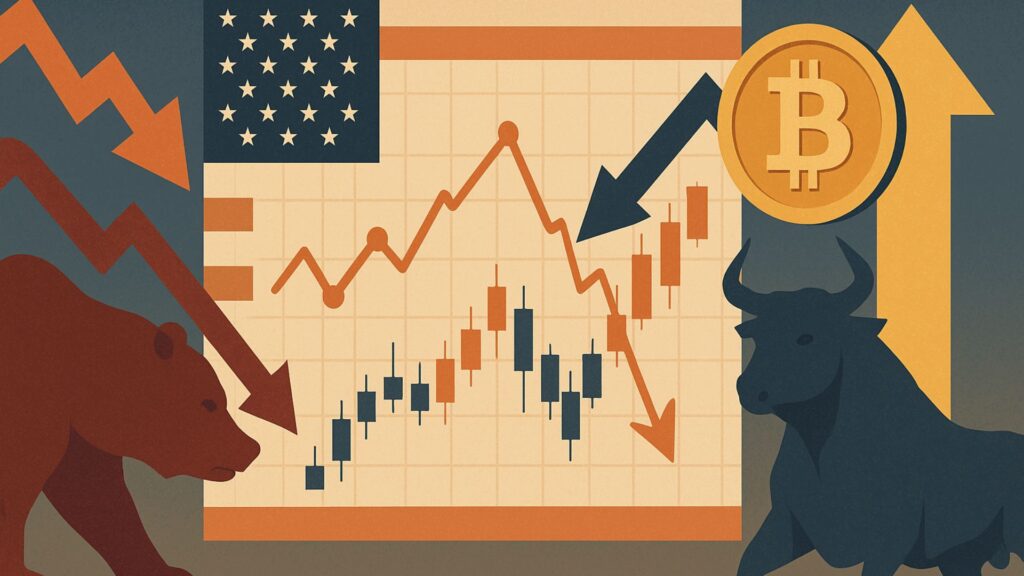Bitcoin briefly surged above $105,000 following the news of a temporary trade agreement between the United States and China.
However, the enthusiasm did not last. While markets initially welcomed the development, broader economic conditions remain unstable. Inflation remains elevated, employment indicators are weakening, and the United States faces a major fiscal decision.
A proposed $4 trillion increase to the debt ceiling may boost liquidity in the short term, but it also introduces new systemic risks that could shape the next phase of market behaviour.
Tariff Truce Calms Markets, But Fails To Shift The Economic Landscape
The 90-day tariff agreement between the United States and China temporarily relieved global markets.
The United States agreed to reduce tariffs on Chinese imports from 145% to 30%, while China lowered its tariffs from 125% to 10%.
Additional retaliatory tariffs imposed in April were also rolled back. These decisions followed two days of meetings in Geneva, and for the moment, tensions have cooled.
Financial markets responded quickly. The S&P 500 rose by 3.3%, the Nasdaq advanced by 4.4%, and the US dollar gained strength against the Japanese yen and Swiss franc.
Gold, often viewed as a defensive asset, declined by 3% as risk appetite returned. Bitcoin climbed past $105,000 but soon retraced to $102,000.
These movements suggested a shift in sentiment, although they were largely driven by immediate headlines rather than long-term improvements.
Underlying conditions in the United States remain fragile. Inflation continues to exceed the Federal Reserve’s 2% target, and unemployment has edged up from 4% in January to 4.2% in both March and April.
Supply chains remain partially disrupted, and consumer spending has shown signs of softening. Although the tariff reduction might ease some pressure, it does not address these broader challenges.
Bitcoin’s response illustrates the market’s sensitivity to policy developments. The brief rally, followed by a retreat, suggests that investors are cautiously optimistic but remain uncertain.
While the tariff pause reduced immediate trade tensions, it has not resolved structural problems within the global economy. As a result, price momentum across risk assets is still constrained by inflationary pressures, policy indecision, and concerns over fiscal sustainability.
Debt Ceiling Expansion, Liquidity Catalyst Or Looming Liability
Beyond trade negotiations, the United States is facing a critical fiscal challenge. Lawmakers are now considering a proposal to raise the national debt ceiling by $4 trillion up to $5 trillion.
This move, if approved, would allow the government to increase spending and fund ongoing tax policy goals.
In the near term, this could boost market liquidity and support asset prices, including Bitcoin. However, the longer-term consequences are far more complex.
A higher debt ceiling would enable the government to inject more capital into the economy through stimulus programmes and public investment. Bitcoin and other risk assets typically benefit from this type of fiscal expansion.
In particular, a rising money supply often strengthens demand for non-sovereign assets. Monthly M2 data already shows consistent increases, which signals that liquidity conditions remain loose.
However, this same dynamic also intensifies inflation risk. If the Federal Reserve continues to accommodate government spending without tightening monetary policy, inflation could remain high or even accelerate.
On the other hand, if the Fed chooses to hold rates steady or increase them, borrowing costs may rise and dampen growth. In both scenarios, the policy environment becomes more volatile.
This is what makes the debt ceiling debate a double-edged policy. While it provides room to avoid default and support short-term growth, it also highlights the growing reliance on credit to sustain public finances. Each new round of borrowing puts additional pressure on central bank decision-making.
Should confidence in the government’s fiscal discipline weaken, the fallout could be severe. Bond markets may respond with higher yields, and capital could flow out of both equities and digital assets.
Bitcoin, as a fixed-supply currency, is often seen as a hedge against inflation and fiat dilution. However, that narrative holds only if market participants remain confident in overall system stability.
If liquidity dries up or risk sentiment turns negative, Bitcoin could face a sharp correction alongside other speculative assets. The key level to watch is $100,000.
So far, it has acted as a reliable support. If it continues to hold, Bitcoin may regain strength and test previous highs. If it breaks, the downside could accelerate, especially if fiscal negotiations stall or inflation worsens.
Conclusion
The tariff agreement between the United States and China delivered a temporary lift to global markets, but it has not changed the broader economic trajectory. Inflation remains high, labour indicators are softening, and the future of fiscal policy is uncertain.
The proposed $4 trillion debt ceiling increase may deliver liquidity in the short term, but it also exposes the economy to new risks.
For Bitcoin, this is both a potential tailwind and a warning. The next market cycle will depend not just on headlines, but on whether the United States can navigate this complex and increasingly unstable policy environment.

